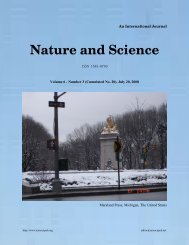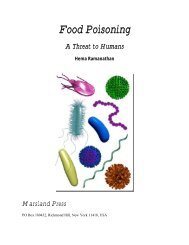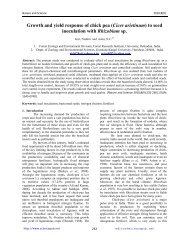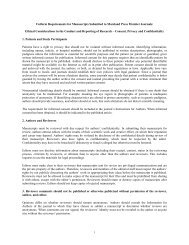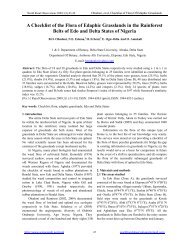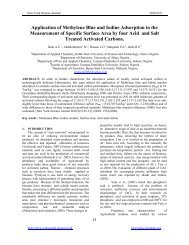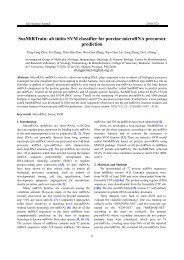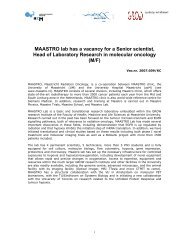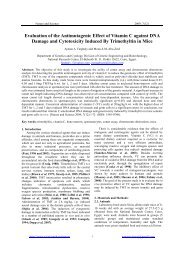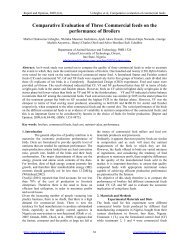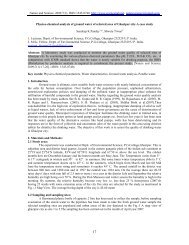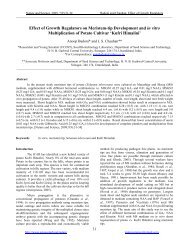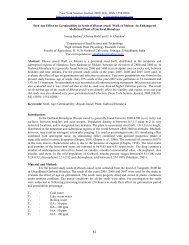Phytochemical screening of the leaves of Lophira lanceolata ...
Phytochemical screening of the leaves of Lophira lanceolata ...
Phytochemical screening of the leaves of Lophira lanceolata ...
You also want an ePaper? Increase the reach of your titles
YUMPU automatically turns print PDFs into web optimized ePapers that Google loves.
Life Science Journal, Vol 4, No 4, 2007<br />
http://lsj.zzu.edu.cn<br />
Table 2. Evaluation <strong>of</strong> results<br />
Percentage (%)<br />
Total ash value content 9.5<br />
Acid insoluble ash value 6.8<br />
Water soluble ash value 6.4<br />
Alcohol soluble extractive value 2.4<br />
Water extractive value 4.9<br />
Table 4. Colour test <strong>of</strong> fraction “A 1 ”<br />
Reagent Colour produced Inference<br />
(1) Mg-HCl Orange ++<br />
(2) Alc.Ferric Chloride Dark green + + +<br />
(3) Zn-HCl Red + +<br />
Table 3. Colour test <strong>of</strong> fraction “A”<br />
Reagent Colour produced Inference<br />
(1) Mg- HCl Orange ++<br />
(2) Alc.Ferric Chloride Dark green + + +<br />
(3) Zn-HCl Red + +<br />
Figure 1. TLC chromatogram <strong>of</strong> fraction “A” in BPF, TPA and B:<br />
EA: A, respectively.<br />
tic sugar. The sample gave a spot with <strong>the</strong> same R f value The result <strong>of</strong> various solvent system used in developing<br />
solvent for <strong>the</strong> TLC on fraction “A” was summarized<br />
equivalent with that <strong>of</strong> an au<strong>the</strong>ntic (reference) glucose<br />
sample.<br />
in Table 6.<br />
3.7 Paper chromatography <strong>of</strong> hydrolyzed sugar<br />
Table 6. Solvent system development<br />
Technique: descending.<br />
Toluene : pyridine : acetic acid 10 : 1 : 1<br />
Paper: whatmann No 1.<br />
Toluene : ethanol 19 : 1<br />
Solvent system : n-butanol : acetate acid : water (4 : 1<br />
Benzene : ethyl acetate : acetic acid 8 : 5 : 2<br />
: 5) developed for 20 hours.<br />
Visualization: after drying in <strong>the</strong> fume cupboard, it was Ethyl acetate : formic acid : water 10 : 2 : 3<br />
sprayed with aniline-H-phthalate and heat at 110 ºC for 5 Chlor<strong>of</strong>orm : ethanol : water 1 : 2 : 1<br />
minutes (Figure 2 and Table 5).<br />
Ethyl acetate : methanol : water 10 : 14 : 1<br />
Methanol : acetic acid 9 : 1<br />
3.8 Paper chromatograpm <strong>of</strong> aglycone before hydrolysis<br />
Technique: descending.<br />
Paper: what mann No 1.<br />
Solvent system: n-butanol : acetate acid : water (4 : 1 :<br />
5) developed for 20 hours.<br />
Figure 2. Paper chromatogram <strong>of</strong> fraction “A” after hydrolysis. Visualization: after drying in <strong>the</strong> fume cupboard, it was<br />
sprayed with ferric chloride and heat at 110 ºC for 5 minutes<br />
(Figure 3 and Table 7).<br />
Table 5. R f value <strong>of</strong> spot in paper chromatogram<br />
<strong>of</strong> fraction “A”<br />
1 Hydrolyzed Portion B<br />
2 Arabinose<br />
3 Xylose<br />
4 Glucose<br />
5 Galactose<br />
6 Rhamnose<br />
Figure 3. Paper chromatogram <strong>of</strong> aglycone before hydrolysis.<br />
7 Fructose<br />
8 Free sugar A 1<br />
∙ 78 ∙



